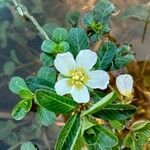Herbs perennial, with creeping or floating stems, rooting at nodes, with white, erect, short (1-3 cm), spindle-shaped pneumatophores in clusters at nodes of floating stems. Floating stems to 400 cm, terrestrial stems 20-60 cm, much branched, tips ascending, glabrous or densely villous. Petiole 5-20 mm; leaf blade oblong to spatulate-oblong, 0.4-7 × 0.7-3 cm, glabrous, lateral veins 6-13 per side, submarginal vein not prominent, base narrowly cuneate or attenuate, margin entire, apex obtuse to subacute. Sepals 5, deltoid-acuminate, 5-11 mm, glabrous or villous. Petals creamy-white with yellow base, obovate, 9-18 × 6-10 mm. Stamens 10; filaments white, 2.5-4 mm; anthers 0.7-1.8 mm; pollen in monads. Style white, 4-10 mm, glabrous; stigma discoid. Capsule light brown with dark brown ribs, cylindric, terete, 1.2-2.7 cm, 3-4 mm in diam., glabrous or villous, thickly walled, tardily and irregularly dehiscent; pedicel 1.5-5.5 cm. Seeds in one row per locule, firmly embedded in coherent cubes of woody endocarp fused to capsule wall, pale brown, oblong or elliptic, 1.1-1.3 mm, raphe inconspicuous. Fl. Apr-Nov, fr. May-Nov. 2n = 32*.
A floating herb. It floats by means of white, air filled outgrowths. It grows 0.1-1 m tall. The stems are long, creeping and fleshy. They can lie along the ground or curve upwards. The stems can be 4 m long. They are rooted in the mud and they form roots at the nodes. The leaves are 3-5 cm long by 1.5-2.5 cm wide. They taper to the base and have a blunt tip. They are oblong and bright green. They are shiny and have a leafy structure at the base of the leaf stalk. The leaf stalk is long. The flowers occur in the axils of the upper leaves. The flowers are 1.8-2.5 cm across. They are creamy white with a yellow centre. The fruit is a capsule 1-2.5 cm long and shaped like a cylinder. It has 10 brown ribs. The seeds are pale brown and 1-1.5 mm long. They are embedded in dense corky tissue.
Herb, hydrophyte, 0.5-1.0 m long; stems prostrate or erect, rooting at nodes, with conspicuous, white, erect, spindle-shaped pneumatophores clustered at nodes of floating stems and from roots. Leaves narrowly lanceolate, 6-12 main veins on each side of midrib. Flowers solitary in leaf axils. Sepals 5; up to 14 x 2.8 mm. Petals up to 18 x 10 mm. Stamens 10; pollen shed singly. Fruit a terete capsule, up to 30 mm long, longitudinally 10-ribbed, bulged at 1.5 mm intervals, light brown, thick walled, tardily dehiscent; pedicels up to 20 mm long. Seeds uniseriate, up to 1.3 mm long, pale brown, firmly embedded in coherent cubes of woody endocarp.
Prostrate or ascending herb rooting at nodes. Stems to c. 60 cm high or several metres long, densely villous to glabrous. Clusters of erect white pneumatophores at nodes of floating stems and on roots. Leaves alternate, broadly elliptic-oblong, 1–7 cm long, acute or obtuse, base tapering; petiole long. Flowers solitary in upper leaf axils; bracteoles deltoid, minute. Sepals 5, deltoid, acuminate. Petals 1–2 cm long, creamy white or pale yellow, darker at base. Stamens 10. Capsule 1–2.5 cm long, terete, thick-walled and tardily and irregularly dehiscent. Seeds in 1 row in each locule and embedded in endocarp.


